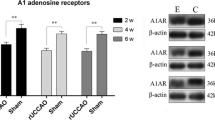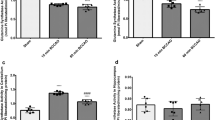Abstract
Conventional protein kinase C (cPKC)γ participated in cerebral hypoxic preconditioning-induced neuroprotection and affected the neurological outcome of ischemic stroked mice. As an independent predictor of ischemic stroke, the internal carotid artery occlusion (ICAO)-caused brain-regional ischemic injury may worsen the neurological outcome of patients. However, the brain-regional ischemic vulnerability and its underlying mechanism remain unclear. In this study, the bilateral ICAO (BICAO) model was applied in cPKCγ wild type (WT) and knockout (KO) mice to determine the cPKCγ impact on brain-regional ischemic vulnerability. The arterial spin labeling (ASL) imaging results showed that 7 days BICAO-induced global ischemia could cause significant blood perfusion loss in prefrontal cortex (69.13%), striatum (61.69%), hypothalamus (67.36%), hippocampus (69.82%) and midbrain (40.53%) of WT mice, along with neurological deficits. Nissl staining and Western blot results indicated that hypothalamus and midbrain had more severe neural cell loss than prefrontal cortex, striatum and hippocampus, which negatively coincided with endogenous cPKCγ protein levels but not blood perfusion loss and cPKCγ membrane translocation levels. Furthermore, we found that cPKCγ KO significantly aggravated the neuron loss in prefrontal cortex, striatum and hippocampus and abolish the regional ischemic vulnerability by using immunofluorescent staining with neuron-specific marker NeuN. Similarly, cPKCγ KO also significantly increased Caspase-3, -8 and -9 cleavage levels in prefrontal cortex, striatum, hippocampus, hypothalamus and midbrain of mice with 24 h BICAO. These results suggested that hypothalamus and midbrain are more vulnerable to ischemia, and endogenous cPKCγ affects the regional ischemic vulnerability through modulating Caspase-8 and -9 dependent cell apoptosis.




Similar content being viewed by others
References
Go AS, Mozaffarian D, Roger VL, Benjamin EJ, Berry JD, Borden WB, Bravata DM, Dai S, Ford ES, Fox CS, Franco S, Fullerton HJ, Gillespie C, Hailpern SM, Heit JA, Howard VJ, Huffman MD, Kissela BM, Kittner SJ, Lackland DT, Lichtman JH, Lisabeth LD, Magid D, Marcus GM, Marelli A, Matchar DB, McGuire DK, Mohler ER, Moy CS, Mussolino ME, Nichol G, Paynter NP, Schreiner PJ, Sorlie PD, Stein J, Turan TN, Virani SS, Wong ND, Woo D, Turner MB, American Heart Association Statistics C, Stroke Statistics S (2013) Heart disease and stroke statistics—2013 update: a report from the American Heart Association. Circulation 127:e6–e245
Waje-Andreassen U, Naess H, Thomassen L, Maroy TH, Mazengia KY, Eide GE, Vedeler CA (2015) Biomarkers related to carotid intima-media thickness and plaques in long-term survivors of ischemic stroke. Transl Stroke Res 6:276–283
Weimar C, Mieck T, Buchthal J, Ehrenfeld CE, Schmid E, Diener HC, German Stroke Study C (2005) Neurologic worsening during the acute phase of ischemic stroke. Arch Neurol 62:393–397
Bjorklund E, Lindberg E, Rundgren M, Cronberg T, Friberg H, Englund E (2014) Ischaemic brain damage after cardiac arrest and induced hypothermia—a systematic description of selective eosinophilic neuronal death. A neuropathologic study of 23 patients. Resuscitation 85:527–532
Skelding KA, Spratt NJ, Fluechter L, Dickson PW, Rostas JA (2012) alphaCaMKII is differentially regulated in brain regions that exhibit differing sensitivities to ischemia and excitotoxicity. J Cereb Blood Flow Metab 32:2181–2192
Radovsky A, Safar P, Sterz F, Leonov Y, Reich H, Kuboyama K (1995) Regional prevalence and distribution of ischemic neurons in dog brains 96 h after cardiac arrest of 0 to 20 min. Stroke 26:2127–2133
Baron JC, Yamauchi H, Fujioka M, Endres M (2014) Selective neuronal loss in ischemic stroke and cerebrovascular disease. J Cereb Blood Flow Metab 34:2–18
Kang BT, Leoni RF, Silva AC (2014) Impaired CBF regulation and high CBF threshold contribute to the increased sensitivity of spontaneously hypertensive rats to cerebral ischemia. Neuroscience 269:223–231
Sakurai-Yamashita Y, Nabika T, Niwa M (2010) Blood pressure-independent factors determine the susceptibility to delayed neuronal death in the stroke-prone spontaneously hypertensive rats. Cell Mol Neurobiol 30:283–287
Hertz L (2008) Bioenergetics of cerebral ischemia: a cellular perspective. Neuropharmacology 55:289–309
Amaral AI, Teixeira AP, Martens S, Bernal V, Sousa MF, Alves PM (2010) Metabolic alterations induced by ischemia in primary cultures of astrocytes: merging 13 C NMR spectroscopy and metabolic flux analysis. J Neurochem 113:735–748
Zhang GR, Liu M, Cao H, Kong L, Wang X, O’Brien JA, Wu SC, Cook RG, Geller AI (2009) Improved spatial learning in aged rats by genetic activation of protein kinase C in small groups of hippocampal neurons. Hippocampus 19:413–423
Aronowski J, Labiche L (2003) Perspectives on reperfusion-induced damage in rodent models of experimental focal ischemia and role of protein kinase C. ILAR J 44:105–109
Chen JL, Lin HH, Kim KJ, Lin A, Forman HJ, Ann DK (2008) Novel roles for protein kinase Cdelta-dependent signaling pathways in acute hypoxic stress-induced autophagy. J Biol Chem 283:34432–34444
Simkhovich BZ, Przyklenk K, Kloner RA (2013) Role of protein kinase C in ischemic “conditioning”: from first evidence to current perspectives. J Cardiovasc Pharmacol Ther 18:525–532
Hongpaisan J, Sun MK, Alkon DL (2011) PKC epsilon activation prevents synaptic loss, Abeta elevation, and cognitive deficits in Alzheimer’s disease transgenic mice. J Neurosci 31:630–643
Zhang N, Yin Y, Han S, Jiang J, Yang W, Bu X, Li J (2011) Hypoxic preconditioning induced neuroprotection against cerebral ischemic injuries and its cPKCgamma-mediated molecular mechanism. Neurochem Int 58:684–692
Deng P, Pang ZP, Lei Z, Xu ZC (2009) Excitatory roles of protein kinase C in striatal cholinergic interneurons. J Neurophysiol 102:2453–2461
Zhao EY, Efendizade A, Cai L, Ding Y (2016) The role of Akt (protein kinase B) and protein kinase C in ischemia-reperfusion injury. Neurol Res 38:301–308
Hang LH, Li SN, Dan X, Shu WW, Luo H, Shao DH (2017) Involvement of spinal CCR5/PKCgamma signaling pathway in the maintenance of cancer-induced bone pain. Neurochem Res 42:563–571
Al-Fayez M, Russell D, Wayne Davies R, Shiels PG, Baker PJ, Payne AP (2005) Deficits in the mid-brain raphe nuclei and striatum of the AS/AGU rat, a protein kinase C-gamma mutant. Eur J Neurosci 22:2792–2798
Ross R, Wang PY, Chari M, Lam CK, Caspi L, Ono H, Muse ED, Li X, Gutierrez-Juarez R, Light PE, Schwartz GJ, Rossetti L, Lam TK (2008) Hypothalamic protein kinase C regulates glucose production. Diabetes 57:2061–2065
Verbeek DS, Knight MA, Harmison GG, Fischbeck KH, Howell BW (2005) Protein kinase C gamma mutations in spinocerebellar ataxia 14 increase kinase activity and alter membrane targeting. Brain 128:436–442
Seki T, Adachi N, Abe-Seki N, Shimahara T, Takahashi H, Yamamoto K, Saito N, Sakai N (2011) Elucidation of the molecular mechanism and exploration of novel therapeutics for spinocerebellar ataxia caused by mutant protein kinase Cgamma. J Pharmacol Sci 116:239–247
Li J, Niu C, Han S, Zu P, Li H, Xu Q, Fang L (2005) Identification of protein kinase C isoforms involved in cerebral hypoxic preconditioning of mice. Brain Res 1060:62–72
Niu C, Li J, Cui X, Han S, Zu P, Li H, Xu Q (2005) Changes in cPKC isoform-specific membrane translocation and protein expression in the brain of hypoxic preconditioned mice. Neurosci Lett 384:1–6
Wei H, Li Y, Han S, Liu S, Zhang N, Zhao L, Li S, Li J (2016) cPKCgamma-modulated autophagy in neurons alleviates ischemic injury in brain of mice with ischemic stroke through akt-mtor pathway. Transl Stroke Res 7:497–511
Pereira FM, Ferreira ED, de Oliveira RM, Milani H (2012) Time-course of neurodegeneration and memory impairment following the 4-vessel occlusion/internal carotid artery model of chronic cerebral hypoperfusion in middle-aged rats. Behav Brain Res 229:340–348
Pintea IL, Rolea E, Balseanu AT, Pirici I, Pop OT, Mogoanta L (2011) Study of cellular changes induced by moderate cerebral ischemia achieved through internal carotid artery ligation. Rom J Morphol Embryol 52:1347–1353
Rodriguez R, Santiago-Mejia J, Gomez C, San-Juan ER (2005) A simplified procedure for the quantitative measurement of neurological deficits after forebrain ischemia in mice. J Neurosci Methods 147:22–28
Wang P, Liang J, Li Y, Li J, Yang X, Zhang X, Han S, Li S, Li J (2014) Down-regulation of miRNA-30a alleviates cerebral ischemic injury through enhancing beclin 1-mediated autophagy. Neurochem Res 39:1279–1291
Kuroiwa T, Mies G, Hermann D, Hakamata Y, Hanyu S, Ito U (2000) Regional differences in the rate of energy impairment after threshold level ischemia for induction of cerebral infarction in gerbils. Acta Neuropathol 100:587–594
Shoykhet M, Simons DJ, Alexander H, Hosler C, Kochanek PM, Clark RS (2012) Thalamocortical dysfunction and thalamic injury after asphyxial cardiac arrest in developing rats. J Neurosci 32:4972–4981
Lin B, Levy S, Raval AP, Perez-Pinzon MA, Defazio RA (2010) Forebrain ischemia triggers GABAergic system degeneration in substantia nigra at chronic stages in rats. Cardiovasc Psychiatr Neurol 2010:506952
Rodriguez-Grande B, Blackabey V, Gittens B, Pinteaux E, Denes A (2013) Loss of substance P and inflammation precede delayed neurodegeneration in the substantia nigra after cerebral ischemia. Brain Behav Immun 29:51–61
Zuhayra M, Zhao Y, von Forstner C, Henze E, Gohlke P, Culman J, Lutzen U (2011) Activation of cerebral peroxisome proliferator-activated receptors gamma (PPARgamma) reduces neuronal damage in the substantia nigra after transient focal cerebral ischaemia in the rat. Neuropathol Appl Neurobiol 37:738–752
Oliveira JM, Goncalves J (2009) In situ mitochondrial Ca2+ buffering differences of intact neurons and astrocytes from cortex and striatum. J Biol Chem 284:5010–5020
Zhu H, Yoshimoto T, Imajo-Ohmi S, Dazortsava M, Mathivanan A, Yamashima T (2012) Why are hippocampal CA1 neurons vulnerable but motor cortex neurons resistant to transient ischemia? J Neurochem 120:574–585
Downey JM, Davis AM, Cohen MV (2007) Signaling pathways in ischemic preconditioning. Heart Fail Rev 12:181–188
Kitagawa K (2012) Ischemic tolerance in the brain: endogenous adaptive machinery against ischemic stress. J Neurosci Res 90:1043–1054
Kurihara J, Katsura K, Siesjo BK, Wieloch T (2004) Hyperglycemia and hypercapnia differently affect post-ischemic changes in protein kinases and protein phosphorylation in the rat cingulate cortex. Brain Res 995:218–225
Hamabe W, Fujita R, Ueda H (2005) Insulin receptor-protein kinase C-gamma signaling mediates inhibition of hypoxia-induced necrosis of cortical neurons. J Pharmacol Exp Ther 313:1027–1034
Hayashi S, Ueyama T, Kajimoto T, Yagi K, Kohmura E, Saito N (2005) Involvement of gamma protein kinase C in estrogen-induced neuroprotection against focal brain ischemia through G protein-coupled estrogen receptor. J Neurochem 93:883–891
Sims NR, Muyderman H (2010) Mitochondria, oxidative metabolism and cell death in stroke. Biochim Biophys Acta 1802:80–91
Degterev A, Yuan J (2008) Expansion and evolution of cell death programmes. Nat Rev Mol Cell Biol 9:378–390
Acknowledgements
This work was supported by grants from the Seed Grant of International Alliance of Translational Neuroscience (PXM2014-014226-000006), Beijing Natural Science Foundation (7132070 and 7141001) and National Natural Science Foundation of China (81301015, 31471142 and 31671205).
Author information
Authors and Affiliations
Corresponding authors
Ethics declarations
Conflict of interest
The authors declare that there are no conflicts of interest.
Rights and permissions
About this article
Cite this article
Liu, S., Dai, Q., Hua, R. et al. Determination of Brain-Regional Blood Perfusion and Endogenous cPKCγ Impact on Ischemic Vulnerability of Mice with Global Ischemia. Neurochem Res 42, 2814–2825 (2017). https://doi.org/10.1007/s11064-017-2294-9
Received:
Revised:
Accepted:
Published:
Issue Date:
DOI: https://doi.org/10.1007/s11064-017-2294-9




